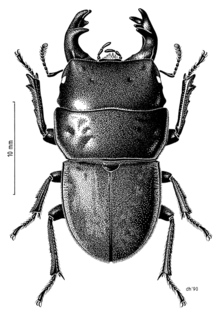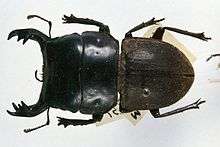Geodorcus ithaginis
| Geodorcus ithaginis | |
|---|---|
 | |
| Illustration by Des Helmore | |
| Scientific classification | |
| Kingdom: | Animalia |
| Clade: | Euarthropoda |
| Class: | Insecta |
| Order: | Coleoptera |
| Family: | Lucanidae |
| Genus: | Geodorcus |
| Species: | G. ithaginis |
| Binomial name | |
| Geodorcus ithaginis | |
| Synonyms | |
|
Lissotes ithaginis Broun, 1893[1] | |
Geodorcus ithaginis, the Mokohinau stag beetle, is a large flightless species of stag beetle in the family Lucanidae. It was described by Thomas Broun in 1893 after being discovered in the Mokohinau Islands by P. Stewart Sandager, a lighthouse keeper on the islands.[2] The species survives only on the small unnamed island "Stack H", in an patch of vegetation the size of a living room, and is in extreme danger of extinction.
Description

Including their large mandibles (used for fighting over mates), male specimens range in length from 25.5 to 32.8 mm and are 10.4–12.4 mm wide. Females range in length from 20.0–22.5 mm. Their exoskeleton is black and ranges from dull to moderately glossy. The thorax is back, glossy, and wider than it is long. The elytra are rounded at the posterior, almost equally long and wide, and covered in short branching hairs.[3] Male beetles have three teeth at the apex of the mandibles; females have two. What distinguishes this species from all other New Zealand stag beetles is a long conical vertical tooth, on the top of the mandible, in both sexes.[4]
Distribution
This species is only known from the Mokohinau Islands in New Zealand. Its type locality was given by Broun as "Halodroma Islet", but there is no island by that name. "Halodroma" may be another name for Lizard Island, a small flat island southeast of Burgess Island;[4] Halodroma urinatrix is the former name of Pelacanoides urinatrix, the diving petrel, which used to nest in burrows on Lizard and two other low Mokohinau islands.[3]
G. ithaginis has been collected in recent times from "Stack H", a 1.2 ha island southwest of Burgess Island.[3] All recent surveys have only found this species in a "living-room sized" patch of New Zealand ice plant or horokaka (Disphyma australe) on Stack H;[5] it has not been seen on Lizard Island since its description in 1893.[4][3]
Habitat
Geodorcus species on mainland New Zealand are associated with rotten logs, but these are absent from Stack H. The Mokohinau Islands are generally very arid, with poor moisture retention.[4] This beetle burrows into a peat-like layer of soil formed by New Zealand ice plant (Disphyma australe). It has also been found under rocks, in the tussock grass Chionochloa bromoides, and in the leaf litter beneath coastal pohutukawa.[4]
Diet
These beetles are nocturnal, and their feeding behaviour is unknown. Adult stag beetles worldwide have mouthparts suited to feeding on liquids. Geodorcus helmsi has been seen feeding on sappy exudations on tree trunks. Rotting wood, tree roots or humus are the most common food sources for stag beetle larvae, and G. ithaginis lives in an environment of enriched humus.[3]
Conservation
Searches specifically for G. ithaginis from 1991 to 1994 in the Mokohinau group of islands only found three live beetles on Stack H; nine beetles is the maximum simultaneously observed in recent times.[6] The Mokohinau Islands have been heavily modified by land clearance, burning, grazing, and introduction of the kiore or Polynesian rat; Lizard Island was briefly colonised by kiore in the late 1970s. Rats were eradicated from all the Mokohinau Islands in the 1990s, but subsequent surveys for G. ithaginis on Lizard Island have been unsuccessful.[3] Fire, storms, and rodent introductions are thought to be the most serious threats to this species' survival. Climate change, resulting in a drying out of the island habitat, may also be a threat.[4] The conservation status of this species is categorised as 'nationally critical'.[7] Like other Geodorcus species, this large, slow-moving beetle is protected from collectors under schedule 7 of the 1953 Wildlife Act.[8] Captive breeding and reintroduction to rat-free islands such as Lizard Island will be important in ensuring this species' survival.[5]
References
- 1 2 Broun, Thomas (1893). Manual of the New Zealand Coleoptera. Wellington: New Zealand Institute. p. 1108. Retrieved 22 January 2017.
- ↑ Watt, J.C. (1977). "Conservation and type localities of New Zealand Coleoptera, and notes on collectors 1770–1920". Journal of the Royal Society of New Zealand. 7: 79–91. doi:10.1080/03036758.1977.10419338.
- 1 2 3 4 5 6 Holloway, B.A. "Lucanidae (Insecta: Coleoptera)" (PDF). Landcare New Zealand. Landcare Research. Retrieved 11 January 2017.
- 1 2 3 4 5 6 McGuiness, C.A. "The Conservation Requirements of New Zealand's Nationally Threatened Invertebrates" (PDF). Department of Conservation. Retrieved 2017-01-22.
- 1 2 "Ten Most Endangered Species". Endangered Species Foundation. Retrieved 21 February 2017.
- ↑ Toki, Nicola; Mulligan, Jesse (17 February 2017). "Critter of the Week: Mokohinau stag beetle". RNZ. Retrieved 21 Feb 2017.
- ↑ Stringer, I.A.N; Hitchmough, R.A.; Leschena, R.A.B.; Marris, J.W.M.; Emberson, R.M.; Nunn, J. (2012). "The conservation status of New Zealand Coleoptera". New Zealand Entomologist. 35 (2). doi:10.1080/00779962.2012.686311.
- ↑ "Wildlife Act 1953". New Zealand Legislation. Parliamentary Counsel Office. Retrieved 25 January 2016.
External links
- Mokohinau stag beetle discussed on Critter of the Week, 17 February 2017
